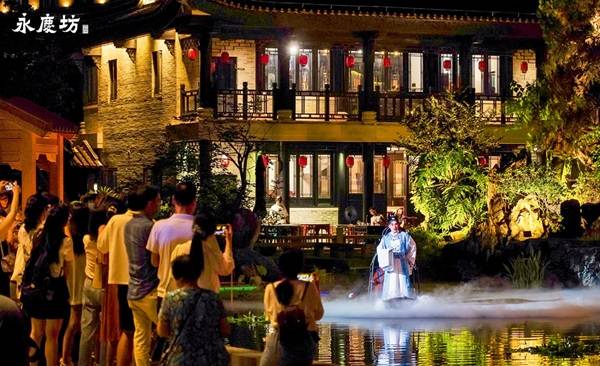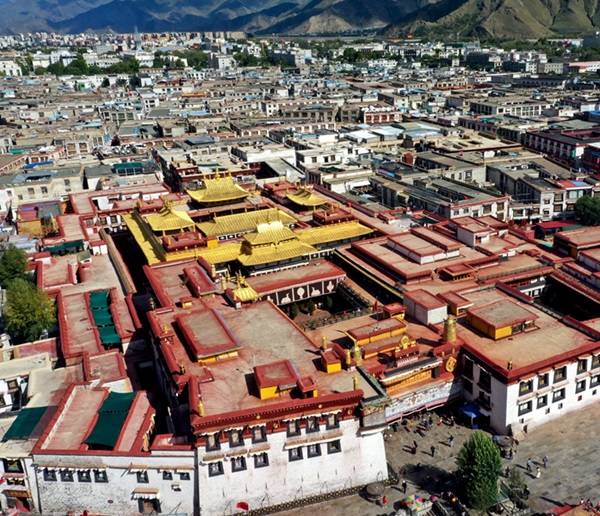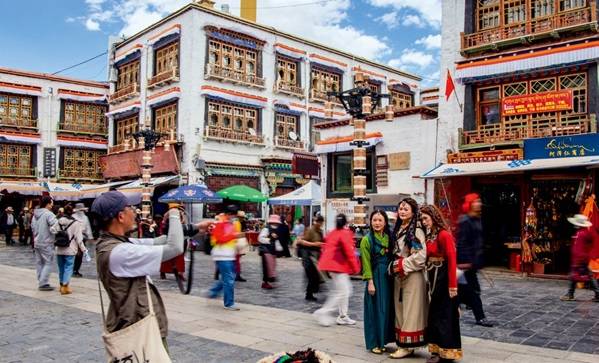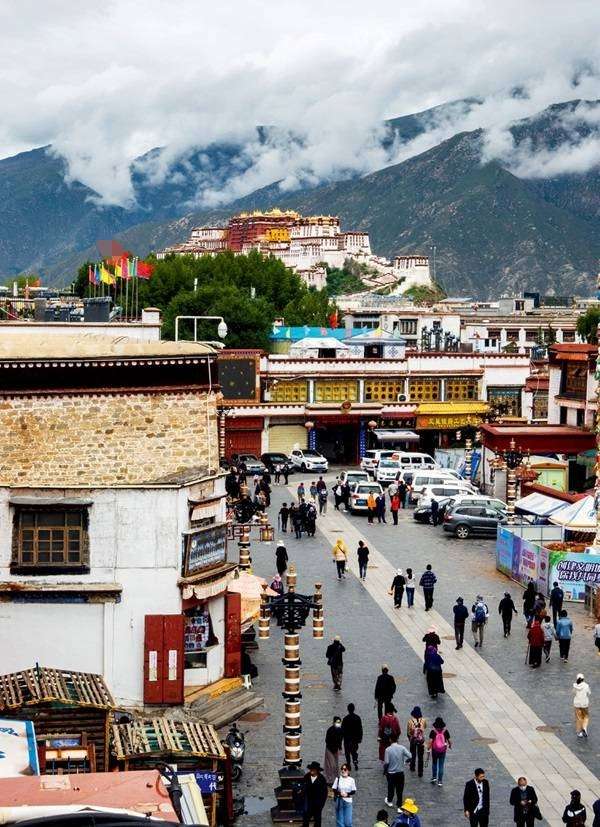



CHINA PICTORIAL 2024-2 Excerpt No.5
Yongqingfang: Historical Block with Fresh Vitality
Text by Zhou Chenliang

Through renovation, Yongqingfang has become one of the most popular tourist attractions in the old district of Guangzhou, capital of southern China’s Guangdong Province. (Photo from VCG)
01
Akitten relaxes in this tranquil alley lit up by sunlight hitting black-tiled roofs of traditional houses and sandstone paths. The sight might have been identical to that a century ago: A graceful woman in traditional costume steps out an old qilou (arcade house) while gently swaying a silk fan. This historical block is called Yongqingfang.
Located on Enning Road, Liwan District of Guangzhou, Yongqingfang is a historical and cultural block blending tradition and modernity with distinctive Cantonese and Lingnan features. Covering 113,700 square meters, Yongqingfang has undergone a series of renovation projects including watercourse harnessing and art museum construction, which have injected infinite vitality into the old block.
The first old district micro-renovation project in Guangzhou, the former Yongqing Street transformed into today’s Yongqingfang. Through well-designed measures, builders strove to improve the local living environment in Yongqingfang while retaining memories of the past.
02
Enning Road is the longest and best-preserved qilou street in Guangzhou. Several historical buildings with the distinctive Lingnan style were preserved in Yongqingfang including the memorial hall for Zhan Tianyou (1861-1919), known as the “father of China’s railroad,” the ancestral home of worldfamous martial artist and actor Bruce Lee (1940-1973), and the Bahe Guild Hall. It is also home to many intangible cultural heritage items such as Cantonese Opera, martial arts, traditional medicine, seal cutting, and paper cutting. Yongqingfang adopted a living heritage approach and achieved seamless fusion of tangible and intangible cultural heritage conservation through blending culture and tourism to meet new demands for economic development and tourist preferences. Today, it has evolved into an outstanding cultural calling card for Guangzhou as a historical block saturated with intangible cultural heritage.

An actress performs on the street in Yongqingfang. On June 8, 2023, the second Yongqingfang Performing Arts Month kicked off, at which locals and tourists alike enjoyed the unique charm of Lingnan culture. (Photo courtesy of the Publicity Department of the CPC Committee of Liwan District, Guangzhou City)

An annual event held at the Cantonese Opera Art Museum, the Cantonese Opera Carnival attracts numerous fans each year. (Photo courtesy of the Publicity Department of the CPC Committee of Liwan District, Guangzhou City)
03
A popular attraction in Yongqingfang, the Cantonese Opera Art Museum features a garden, an exhibition hall, and a theater. At the heart of the garden zone is an artificial lake surrounded by six groups of interconnected courtyard buildings. The buildings are shrouded in a haze from the vast lake, creating a fairytale vista. In 2017, the museum won the China Construction Engineering Luban Prize, the country’s most prestigious award for construction and engineering quality.
Through renovation of historical buildings, renewal of traditional culture, and introduction of new business patterns, Yongqingfang has emerged as a cultural and artistic hub blending tradition and modernity and an internet-famous landmark awakening memories of old Guangzhou.
Barkhor Street: Brimming with Ethnic Flavor
Text by Zhi Mo
04
In the heart of Lhasa, southwestern China’s Tibet Autonomous Region, the ancient and cultured Barkhor Street has already been around for more than 1,300 years. Barkhor, which means “pilgrim’s inner circuit” in the Tibetan language, is a circular street surrounding Jokhang Monastery. Composed of Barkhor East Street, Barkhor West Street, Barkhor South Street, Barkhor North Street, and many backstreets and alleys, the network is situated within a perimeter of more than 1,000 meters. It has preserved the traditional religion, culture, and ethnic handicrafts of Lhasa as well as traditional lifestyles of Tibetans.
05
Walking Barkhor Street enables tourists to travel across Lhasa’s thousandyear history. Jokhang Monastery, with a history of more than 1,300 years, houses a life-size gilded bronze statue of 12-year-old Shakyamuni. The Tang-Tubo Alliance Monument, erected in front of Jokhang Monastery in 823, stands as historical proof of unity and friendship between Han and Tibetan peoples. On Barkhor North Street is the former office for the commissioner dispatched by the central government to Tibet during the Qing Dynasty (1644-1911).
A labyrinth-like block comprised of 35 roads and alleys, Barkhor Street is home to residents from more than 20 ethnic groups including the Tibetan, Han, and Hui. It also hosts many shops including those selling thangka paintings, hand-woven carpets and rugs, and specialties from all over Tibet. Among them, handicraft shops are particularly popular with tourists.

With a history of 1,300 years, Jokhang Monastery is the most revered monastery in Lhasa and home to many historical relics and typical Tibetan architecture. (Photo from VCG)

Tourists wearing Tibetan clothes pose for pictures. (Photo from Xinhua)
06
Syamukapu Nepali Shop, one of the oldest shops on Barkhor Street, sells gilded bronze Buddha statues from Nepal. The founder of the shop was Nepalese. Legend holds that more than a century ago, he crossed the Himalayas to Lhasa by horse with clothing, rice, matches, and other goods, and rented a store on Barkhor Street to do business. Since he always wore a white hat, locals nicknamed him “Syamukapu,” meaning “white hat” in Tibetan, which was eventually adopted as the name of the shop. Now, his grandson has taken over the family business. Above the red door hangs a sign with the name of the shop in golden letters in Tibetan, Han, and English. Now in his 60s, current store owner Ratna Kumar Tuladhar says that over the past century, the friendship with Lhasa locals has been the most valuable gift his shop has received.
07
The Jebum-gang Art Center has become a new tourist hotspot in Lhasa in recent years. Hidden in a quiet courtyard north of Barkhor Street, it is Tibet’s first cultural and artistic venue housed in an ancient structure through protective renovation. Visitors can witness the Mandala schematic structure — quite rare in Lhasa — and see exquisite murals from the Qing Dynasty while listening to Tibetan classical music and reading Tibetan history.
08 the last paragraph
Tourists in groups who are dressed in bright and colorful Tibetan costumes to take photos can be found all over Barkhor Street. Photographers feverishly guide them to assume various poses. Travel photography on Barkhor Street is booming, which has fostered many related services and products. After seeing videos of Barkhor Street on the internet, many people become determined to dress in gorgeous Tibetan costumes and have photos taken there. They make reservations on the internet, hire photographers, and book costumes and stylists before taking photos. Ancient Barkhor Street is embracing new development opportunities for sure.

Barkhor Street is a famous commercial hub in Lhasa, offering many shops and stalls. (Photo from VCG)